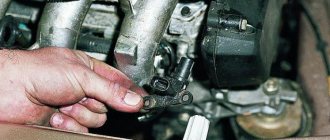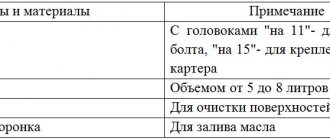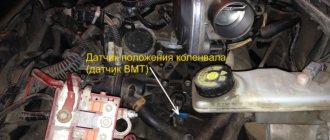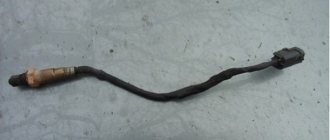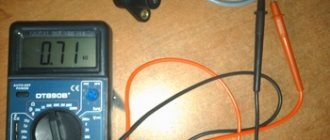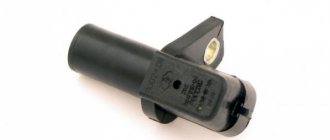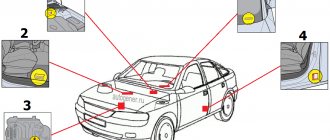Almost all modern engines are stuffed with various electronics and sensors that are needed to control the engine and much more. Currently, there are fewer and fewer cars with simple carburetor engines that had virtually no electronics. They were replaced by powerful and economical engines capable of reaching high speeds, but the maintainability of these cars was gone. The difficulty of finding a breakdown and the variety of number of sensors make troubleshooting very difficult and time-consuming, but if you connect special equipment to the car, then everything immediately becomes clear.
There are a lot of such sensors in the Chevrolet Cruze, but if they break down, there are sensors that the car can continue to move independently until service, and there is one sensor called the crankshaft position sensor (CPS), without which the car’s engine will not even start.
This article talks about the crankshaft sensor on a Chevrolet Cruze, namely, issues related to its breakdowns, locations, as well as self-replacement, cost and much more.
Purpose and principle of operation of the Chevrolet Cruze crankshaft sensor
The sensor belongs to the main sensors of the engine control system. It is designed for general synchronization of the operation of the vehicle’s ignition system and fuel injection. The main task of the sensor is to monitor the angular position of the car's crankshaft. In most cars, like in the Chevrolet Cruze, this task is accomplished using special marks (teeth) applied to the flywheel. As the crankshaft rotates, the flywheel teeth rotate synchronously with it. Passing through the field of the electromagnetic sensor, they induce electrical impulses.
Some Chevrolet Cruze engine models use an electromagnetic sensor with a built-in amplifier, which converts the analog sensor signal into a digital (two-level) one. Due to this, the noise immunity of the sensor increases and the accuracy of setting the ignition angle increases.
If the crankshaft sensor fails, the engine control unit does not generate synchronous pulses for fuel injection and the ignition system. The engine stalls and will not start again.
in our VKontakte group
DIAGNOSE YOUR CAR YOURSELF!
The 58X control signal is generated by the crankshaft position sensor. During one revolution of the crankshaft, 58 pulses are produced. The ECM uses the 58X reference signal to calculate engine speed and crankshaft position. The ECM continuously monitors the number of pulses in the 58X reference signal circuit and compares them with the received crankshaft position signal pulses.
Condition for the DTC to Occur
Conditions for setting the DTC.
The minimum crankshaft position sensor signal voltage is less than 1.3196 V. or the maximum crankshaft position sensor signal voltage is greater than 2.3998 V. or the difference between the minimum and maximum crankshaft position sensor signal voltage is greater than 0.3617.
Action Taken When the DTC Sets
The malfunction indicator lamp lights up. The controller records the operating conditions at the time the fault is detected. This information is stored in a status record buffer and fault logs. An archive of diagnostic trouble codes is saved.
Conditions for Clearing DTC/Malfunction Indication
The malfunction indicator lamp turns off after three consecutive test cycles have completed without failure. The historical DTC clears after 40 heat cycles without failure. The DTC can be cleared by a scan tool.
Diagnostic guidelines
An intermittent fault may be caused by a loose connection, chafed insulation, or broken wiring under the insulation. Check: Loose Connection - Check the ECM wiring harness and connectors for loose connections, faulty locks, bent or damaged terminals, and loose terminal-to-wire connections. Harness damage - Inspect the wiring harness for damage. If the harness appears to be OK, disconnect the ECM, turn the ignition switch ON, and observe the voltmeter reading on test circuit 58X by moving the ECM-related connectors and harnesses. Changes in signal level will indicate the location of the fault. Review the mileage of fault records as failed diagnostic tests will help evaluate the conditions under which the DTC was set. This will help diagnose the conditions.
Crankshaft sensor failure is a critical malfunction of the Chevrolet Cruze. The sensor has a limited resource. As a rule, problems with it appear after 7–10 years of vehicle operation.
Main reasons for failure
The main reasons for failure of the crankshaft sensor include:
- Natural wear and tear. The sensor is installed on the engine in the flywheel area. During the operation of a car, it is exposed to high temperature changes, as a result of which its structure can receive microcracks into which liquids and oils enter, which leads to corrosion.
- Contamination of the working surface with metal shavings. This process significantly reduces the sensitivity of the sensor and can lead to signal loss. As a rule, this reason occurs on “older” cars. In most cases, cleaning the working surface of the sensor is not successful.
- Mechanical damage. Such a malfunction is most likely the result of incorrect installation, replacement with a sensor from another engine modification, or a traffic accident.
- Broken electrical wiring or destruction (corrosion) of the sensor connector.
The true reason for the failure of most crankshaft sensors is the destruction of the electromagnetic sensor. It represents an inductor wound around a core of magnetic material. The winding is made of a very thin copper conductor in varnish insulation. As a result of repeated heating and cooling of the sensor, the thinnest conductor can receive a micro-rupture. As the sensor heats up, the coil breaks, the sensor stops working, the car stalls, then cools down, the coils close again and the engine can start again. In such a situation, experienced car enthusiasts place a rag soaked in cold water on the sensor. This way you can get to the parking lot or repair site.
Signs and prerequisites for a malfunction of the Chevrolet Cruze crankshaft sensor
Experience in operating Chevrolet Cruze vehicles shows that in most cases the crankshaft sensor does not immediately fail. This is preceded by a certain time with the following symptoms. The engine starts, after 12 - 22 minutes of driving or warming up, an engine error indication “CHECK ENGINE” appears on the dashboard. The engine starts to run rough, then stalls. Attempts to restart are unsuccessful. After parking for half an hour after the engine has cooled down, it starts again, the situation continues in the same vein.
The simplest and most informative way to monitor a sensor is computer diagnostics. Trouble code P0335 indicates a faulty crankshaft sensor circuit and must be replaced.
Replacing the sensor
When purchasing a crankshaft sensor for a Chevrolet Cruze, you should pay attention to its markings (part number). For engines with a volume of 1.8 l F18D4, the original part number from General Motors is 55567243. The sensor for engines HR51S, HR52S (analogue) has part number 33220-80G00. Its price is about 1,500 rubles.
When purchasing a sensor, it is better to have an original spare part in order to check the exact fit of the mounting dimensions. There are cases of purchasing Chinese “dummies” on the market, that is, sensors without electronic “internals”.
The sensor is located in the engine flywheel area. The replacement process is simple and takes a few minutes. The sensor is attached to one bolt. After replacing the crankshaft sensor, re-diagnosis of the engine and resetting (deleting) errors is required.
Recommendations for care and maintenance of the sensor
To ensure that the sensor on your Niva Chevrolet functions reliably, follow these recommendations :
- Strictly follow the manufacturer's requirements (they are set out in the instructions).
- Observe the frequency of maintenance.
- Use the appropriate parts, the part numbers of which correspond to the vehicle markings.
- Installing the sensor yourself is not difficult, but experience is still welcome. If the work has not been performed at all before, it is recommended to contact specialized workshops.
- You cannot install sensors from other technical means, despite their external similarity. Full functionality will not be guaranteed.
The service life of sensors on average is more than 80,000 km, but subject to proper replacement and care of the element in accordance with the manufacturer’s instructions.
What is the crankshaft sensor for?
The first thing you should understand is that without a crankshaft sensor on a Chevrolet Cruze you won’t be able to go anywhere. This is the only sensor in the car, without which it is simply impossible to start the engine. It is also sometimes called a timing sensor. This is because this particular part allows the electrical controller to synchronize its work with the car’s gas distribution system, thereby controlling the ignition system and fuel injection.
In fact, this system is quite simple and consists of creating specialized inductive pulses or signals. At the moment when the teeth of the crankshaft pulley cross the line of the core, electrical impulses occur. That is, it is an electromagnetic element capable of synchronizing the operation of injectors in the fuel system.
Throttle position sensor
This device is located directly on the throttle body itself and is connected to the damper axis. Therefore, the sensor can easily determine the opening and closing angle of the damper.
In case of any disturbances in the throttle, the valve stops opening to the required angle or does not close completely. In this regard, the driver feels jerking while driving, because the engine does not have enough fuel or, conversely, the air-fuel mixture is excessively rich.
The throttle sensor is mounted directly on the throttle body
How to change
This is the first sensor in the car system, according to which the vehicle's ECU begins the process of driving the car when the engine starts. In the event of a malfunction of this mechanism, the engine control unit relies on a signal sent from the camshaft sensor. But the ECU needs extra time to do this. Accordingly, if your Chevrolet Cruze starts to start a little later, a few minutes after the starter starts, then it’s time to check whether the crankshaft sensor is working properly.
This element in the Chevrolet Cruze is located at the bottom of the cylinder block, not far from the flywheel, approximately under the oil filter, slightly to the right of it. Based on the signals from this sensor, the ECU calculates the crankshaft speed and the position in which it is located.
In Chevrolet, this element reacts to the close passage of the teeth of the drive disk, which must be attached directly to the cheek of the crankshaft of the fourth cylinder. These teeth are located on the disc at approximately six-degree intervals.
In the process of passing this groove near the element, a reference pulse is created in it, which is synchronization. The installation gap between the main tip of the teeth and the core is approximately 1.3 millimeters. When the master disk rotates, the magnetic flux in the magnetic conductor sensor immediately changes. The winding of this element contains alternating current pulses. Based on the number of pulse data, the ECU calculates the time phase for monitoring pulses, ignition coils and injectors.
The replacement process is as follows:
- First of all, you need to disconnect the negative terminal on the battery.
- Then we disconnect the electrical connector of the crankshaft position sensor and the plastic wire holder.
- Use a special hexagon to remove the bolts that secure the element itself.
- Use a hexagon to remove the bolt of the Cruze crankshaft position sensor and remove the sensor itself.
- We mount a new one and then tighten the bolt to 6.5 N•m.
- We connect the wire block and mount the special plastic holder in place.
- Connect the battery terminal (negative).
- We start the internal combustion engine and, if the “check” does not light up, and the engine runs smoothly, then we enjoy the results of the work done).
Diagnostics of DPKV Chevrolet Lacetti
The easiest way to make sure that the cause of unstable engine operation is a faulty DPKV is to replace this part with a known-good element. First of all, you will need to find this part on the Chevrolet Lacetti engine. The sensor is located near the oil filter.
When the location of the part has been established, the process of performing such an operation should be carried out according to the following algorithm:
- Disconnect the negative terminal of the battery.
- Remove the wires from the DPKV.
- Unscrew the sensor mount (use a hex key).
- Install a new sensor.
- Connect the contact wires.
- Tighten the DPKV fastening.
- Connect the battery.
- Start the engine.
If after the work done the Chevrolet Lacetti engine runs perfectly smooth, this means that this part was the cause of the malfunction. Otherwise, you will need to check other sensors and electrical devices of the engine starting system.
Where is the Crankshaft Sensor on a Chevrolet Cruze?
Damage to the crankshaft sensor is a critical problem in the Chevrolet Cruze. The sensor has a limited resource. You start having problems with it after 7 - 10 years of using the car.
The sensor is one of the main sensors of a set of engine management accounting programs. Designed for general synchronization of the operation of a complex of accounting programs for vehicle ignition and fuel injection. The main task of the sensor is to monitor the angular position of the vehicle's crankshaft. In most cars, like the Chevrolet Cruz, this task is solved with the help of special teeth (teeth) attached to the flywheel. At one time the teeth of the crankshaft rotate, the flywheel rotates synchronously with it. Passing in the area of the electrical sensor, they induce electronic impulses.
Fuel level
As for this device, the fuel level sensor is designed to transmit an impulse to the corresponding indicator located in the control panel. In accordance with these values, the car owner can know what level of fuel is in the tank and when to refuel the car. The regulator is mounted at the bottom of the fuel tank.
- Malfunction of the crankshaft position sensor.
- Damaged ring gear.
- Damage or breakage of the DPKV wiring.
- Short circuit or break in the sensor output signal.
- Timing belt (chain) slipping or breaking.
- ECU malfunction (rare).
The P0335 code is very serious if you have any symptoms while driving. Continuing to drive may cause engine damage and the car may not start until you correct the problem.
If the only symptom is the activation of the Check Engine Light, P0335 is not as serious. You should still fix the problem as soon as possible, but you can still drive your car.
Chevrolet Cruze engine management system sensors
To ensure high-quality operation of the internal combustion engine and other components, modern cars use many different regulators and devices. Failure of one or another element can lead to incorrect operation of the power unit and other components. From this material you can find out what the DTOZH, ABC controller, crankshaft position sensor and other regulators are in the Chevrolet Cruze.
The operation of the ABS sensor in Cruz 2 is based on the principle of electromagnetic induction. When the wheel rotates, the teeth and cavities of the rotor move past the controller, which induce an electrical signal in the winding of the device. The frequency of this signal is proportional to the angular speed of the wheel, as well as the number of teeth on the rotor. If the anti-lock braking system controller in the second Cruze fails, it must be changed, since operating the car in winter will be unsafe (the author of the video is the AVTOTEMA TV channel).
Oxygen sensor
The oxygen sensor is designed to monitor the volume of oxygen levels in exhaust gases. The on-board computer of the Chevrolet Cruze 2, guided by the values, adjusts the quality of the combustible mixture. Euro-2 models have only one regulator, mounted in the exhaust manifold. In Euro-3 versions there are 2 sensors, the second is diagnostic, it is mounted behind the catalyst and monitors the efficiency of its functioning.
It should be noted that the sensor is equipped with a heating system, since it is located far from the collector. If the regulator fails, the control unit goes into emergency operation mode, and a corresponding indicator appears on the device.
The DTOZH in the Cruze 2 car is designed to control the temperature of the antifreeze in the cooling system, according to which the on-board computer regulates the quality of the air mixture. When the device breaks down, starting the power unit will be more difficult, especially in winter, and its breakdown is also fraught with increased fuel consumption. In Euro 2 models, the coolant temperature sensor is located under the ignition distributor, and in Euro 3 - directly under the coils.
Overview of the main sensors of the Volkswagen Golf
The latest versions of the Volkswagen Golf are equipped with a huge variety of sensors. They all differ:
- number of contact connections;
- location;
- dimensions;
- fastening methods;
- resistance performance characteristics, etc.
The most modern cars are equipped with electronic tracking sensors in every mechanism and system
The main purpose of any sensor is to promptly alert the driver that there is a problem with the system. Moreover, each Volkswagen Golf model has both active and passive sensors. Active devices produce an electrical signal due to internal energy conversion, while passive devices convert external kinetic energy.
Today, both active and passive sensors are being implemented in almost all vehicle systems:
- in the engine they are needed to measure temperature and pressure so that the driver can control the load on the power unit;
- in the gearbox, sensors measure movement speed and position;
- In the lubrication system, the role of sensors can hardly be overestimated - they determine the amount of oil and its viscosity.
Sensors on Volkswagen Golf vary in purpose.
Pedal positions
The clutch pedal position controller in Cruzes is installed on the base of the pedal. The purpose of the part is to provide a flexible control scheme for motor modes. Thanks to the DPP, possible drops in speed are eliminated, as well as jerks of the car as a result of changing gears in the “mechanics”. In addition, proper operation of the device can reduce fuel consumption. Thanks to signals from the device, the control unit can increase or decrease engine speed at a certain moment, as well as adjust the ignition angle.

